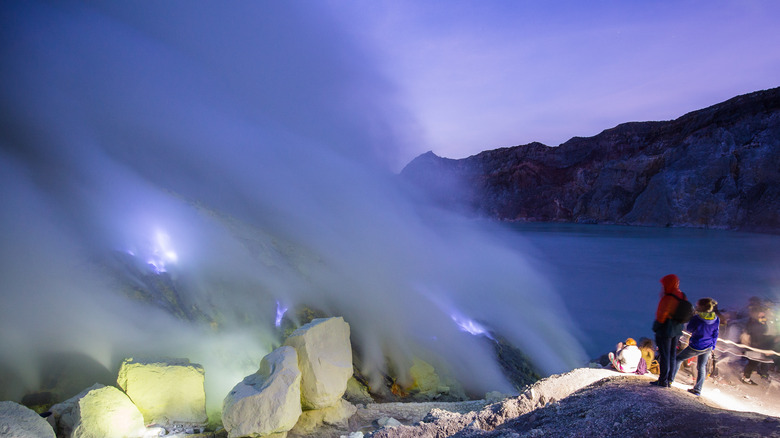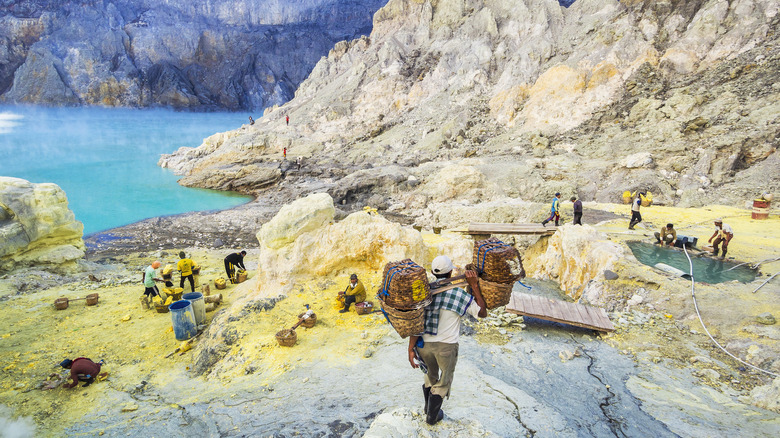Does visiting the world’s largest acidic lake that spews electric-blue fire sound like your cup of tea? In that case, Mount Ijen (known as “Kawah Ijen,” which means “lonely crater”) should definitely be on your bucket list. Nestled in Banyuwangi in the eastern part of Java, Indonesia, this active stratovolcano is a stunning UNESCO Global Geopark. For adventurers seeking an unparalleled hiking experience with a rewarding view, a trek to Mount Ijen is a must.
The adventure to Mount Ijen typically starts in the early morning hours; this journey will test your endurance but also reward you with one of the most unique natural spectacles on Earth. The hike to the crater rim takes about an hour and a half and is approximately two miles long, but don’t let the distance fool you. The path is steep and can be challenging, especially for those not used to high-altitude trekking. The elevation starts at 6,120 feet, ending at 7,550 feet — a total gain of 1,430 feet.
Hiking Mount Ijen requires preparation. Wear appropriate hiking gear and bring layers of clothing, as temperatures vary depending on the time of day and season. A gas mask is essential; goggles are also a good idea — the sulfur fumes near the crater are toxic and overwhelming. It’s advisable to carry a flashlight or headlamp for the night hike. You can ask your hotel if they can provide this equipment for you or rent it in the area. Bring along some snacks and plenty of water.
Blue flames and the crater lake at Mount Ijen

One of Mount Ijen’s most mesmerizing features is its famous blue flames, visible only at night as they swirl within clouds of smoke against the pitch-black sky. These flames are caused by the combustion of sulfuric gases at temperatures of nearly 1,112 degrees Fahrenheit. Danakil, Ethiopia, is the only other place in the world that experiences this rare phenomenon. The best time to witness these surreal blue fires is around 5 a.m.
As dawn breaks and you reach the crater’s edge, the flames fade away, and the sun illuminates one of the best volcano views in the world: Ijen Crater Lake. With a diameter of 2,624 feet and a depth of nearly 600 feet, it’s known as the largest acidic crater lake in the world. You may be wondering if you can touch the water — yes, but not for long. It’s hot, around 140 degrees, and can cause skin irritation due to an acidity level of 0.3, which is very acidic.
The shimmering shades of the water change depending on the season, time of day, and the volcano’s activity. Its color can go from turquoise to green to a muddy white, contrasting the rugged landscape and yellow sulfur deposits. Dissolved metals, hydrochloric and sulfuric acids in the water are responsible for this dazzling array of hues. At the depths of the lake is volcano magma, which remains locked. In the case of volcanic activity, only methane gas comes to the surface.
Travel tips for Mount Ijen

Mount Ijen is not only a natural wonder but one of the last remaining sites of traditional sulfur mining. For over 700 years, local miners have made the arduous trek up the mountain and down into the crater to extract sulfur, also known as the “Devil’s gold.” They do this under extremely harsh conditions, carrying 165 to 198 pounds of sulfur blocks on their shoulders. Observing their hard work in such hazardous conditions is both humbling and eye-opening. That said, being respectful of the miners and understanding the cultural context of the area is very important.
The best time to hike Mount Ijen is during the dry season, from April to October. You’ll typically start your journey from Bali or Jakarta by flying or taking a ferry to the nearest entry point in East Java, such as Surabaya or Banyuwangi. Banyuwangi or Bondowoso are the closest cities to Mount Ijen and serve as bases for your trip. Accommodations are available in these cities, ranging from budget hostels to more luxurious options.
Given the challenges and potential hazards of visiting a volcanic area, many travelers opt for guided tours, such as one from Bali or another from Banyuwangi. These tours often include transportation, a guide, safety equipment, and pre-paid entry fees. If you go independently, note the entrance fee for weekdays is $7 and weekends is $10. Check the latest local regulations because sometimes the volcano is closed due to increased volcanic activity or gas risks.

